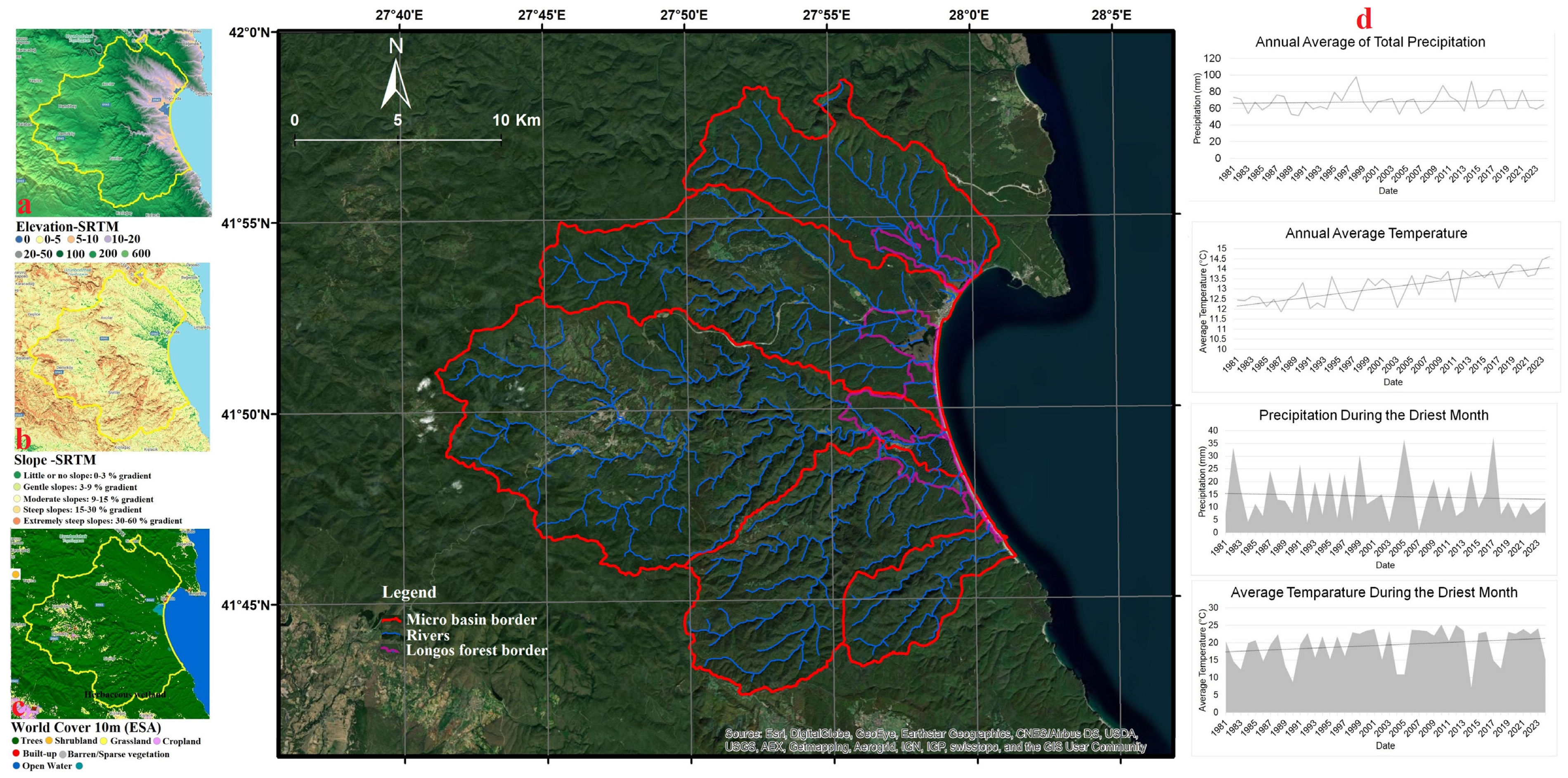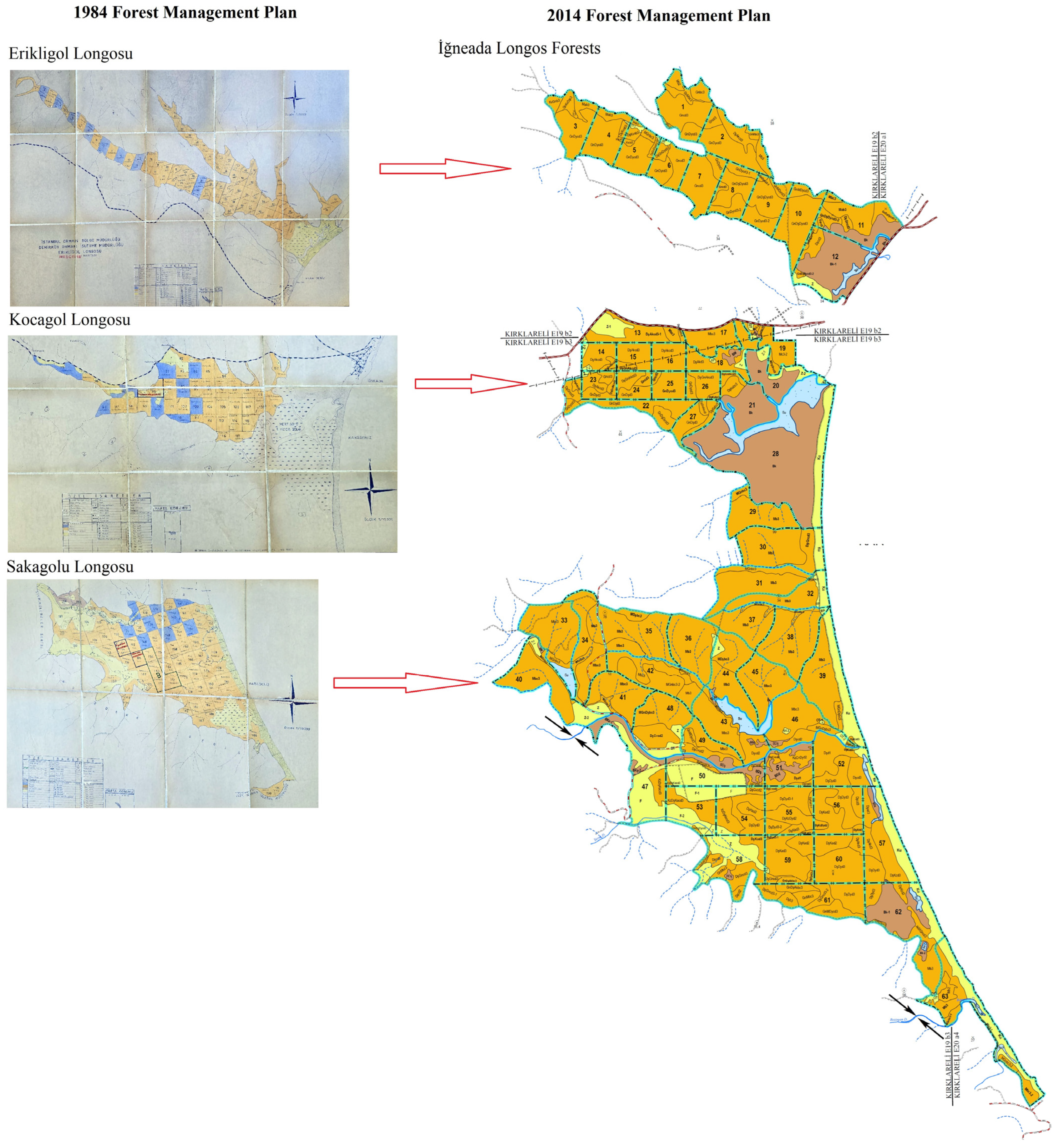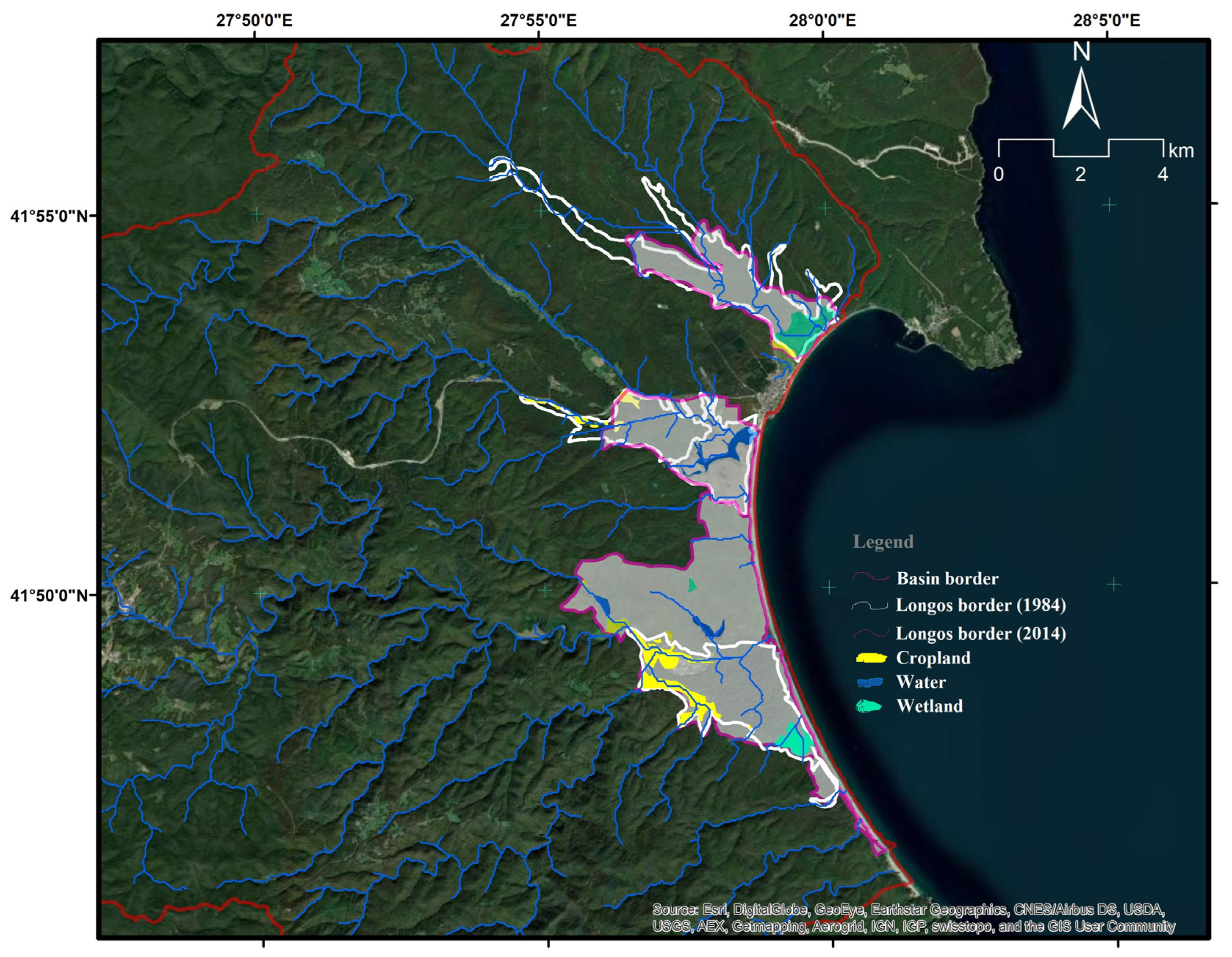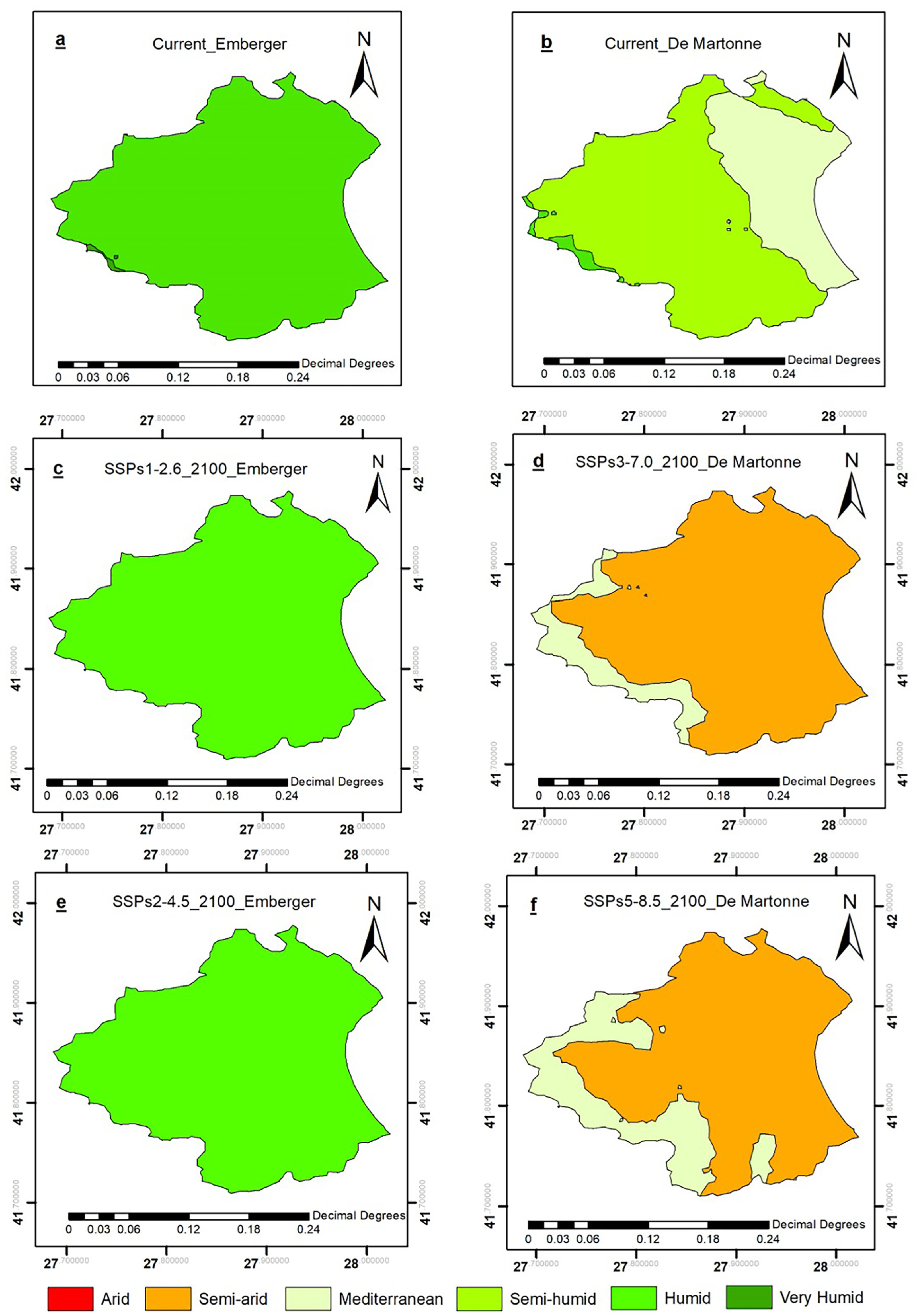Vulnerability and Adaptation of Coastal Forests to Climate Change: Insights from the Igneada Longos Forests of Türkiye
Abstract
1. Introduction
2. Materials and Methods
- P is the annual precipitation (mm);
- T is the annual average air temperature (°C);
- The number 10 is the coefficient employed for the acquisition of positive values.
- P represents the annual average precipitation (mm);
- M represents the average maximum monthly air temperature of the warmest month in absolute degrees (K);
- m represents the average minimum monthly air temperature of the coldest month in absolute degrees (K).
3. Results and Discussion
3.1. Forest Management Plan LULC Changes
3.2. Assessment of Climatic Shifts Under SSPs
4. Conclusions
Author Contributions
Funding
Data Availability Statement
Conflicts of Interest
References
- Jiang, J.; DeAngelis, D.L.; Teh, S.-Y.; Krauss, K.W.; Wang, H.; Li, H.; Smith, T.J., III; Koh, H.-L. Defining the next Generation Modeling of Coastal Ecotone Dynamics in Response to Global Change. Ecol. Model. 2016, 326, 168–176. [Google Scholar] [CrossRef]
- Krauss, K.W.; Noe, G.B.; Duberstein, J.A.; Conner, W.H.; Stagg, C.L.; Cormier, N.; Jones, M.C.; Bernhardt, C.E.; Graeme Lockaby, B.; From, A.S. The Role of the Upper Tidal Estuary in Wetland Blue Carbon Storage and Flux. Glob. Biogeochem. Cycles 2018, 32, 817–839. [Google Scholar] [CrossRef]
- Ardón, M.; Potter, K.M.; White, E., Jr.; Woodall, C.W. Coastal Carbon Sentinels: A Decade of Forest Change along the Eastern Shore of the US Signals Complex Climate Change Dynamics. PLoS Clim. 2025, 4, e0000444. [Google Scholar] [CrossRef]
- Cormier, N.; Krauss, K.W.; Conner, W.H. Periodicity in Stem Growth and Litterfall in Tidal Freshwater Forested Wetlands: Influence of Salinity and Drought on Nitrogen Recycling. Estuaries Coasts 2013, 36, 533–546. [Google Scholar] [CrossRef]
- Haaf, L.; Dymond, S.F. Growth Conditions of Tree Species Relative to Climate Change and Sea Level Rise in Low-Lying Mid Atlantic Coastal Forests. Front. For. Glob. Chang. 2024, 7, 1362650. [Google Scholar] [CrossRef]
- Conner, W.H.; Doyle, T.W.; Krauss, K.W.; Doyle, T.W.; O’Neil, C.P.; Melder, M.P.V.; From, A.S.; Palta, M.M. Tidal Freshwater Swamps of the Southeastern United States: Effects of Land Use, Hurricanes, Sea-Level Rise, and Climate Change. In Ecology of Tidal Freshwater Forested Wetlands of the Southeastern United States; Springer: Berlin/Heidelberg, Germany, 2007; pp. 1–28. [Google Scholar]
- Antonellini, M.; Mollema, P.N. Impact of Groundwater Salinity on Vegetation Species Richness in the Coastal Pine Forests and Wetlands of Ravenna, Italy. Ecol. Eng. 2010, 36, 1201–1211. [Google Scholar] [CrossRef]
- Alongi, D.M. The Impact of Climate Change on Mangrove Forests. Curr. Clim. Chang. Rep. 2015, 1, 30–39. [Google Scholar] [CrossRef]
- Schaeffer-Novelli, Y.; Soriano-Sierra, E.J.; Vale, C.C.D.; Bernini, E.; Rovai, A.S.; Pinheiro, M.A.A.; Schmidt, A.J.; de Almeida, R.; Coelho, C.; Menghini, R.P. Climate Changes in Mangrove Forests and Salt Marshes. Braz. J. Ocean. Oceanogr. 2016, 64, 37–52. [Google Scholar] [CrossRef]
- Yang, H.; Zhang, X.; Hong, Y. Classification, Production, and Carbon Stock of Harvested Wood Products in China from 1961 to 2012. Bioresources 2014, 9, 4311–4322. [Google Scholar] [CrossRef]
- Wasson, K.; Woolfolk, A.; Fresquez, C. Ecotones as Indicators of Changing Environmental Conditions: Rapid Migration of Salt Marsh–Upland Boundaries. Estuaries Coasts 2013, 36, 654–664. [Google Scholar] [CrossRef]
- Smith, A.J.; Goetz, E.M. Climate Change Drives Increased Directional Movement of Landscape Ecotones. Landsc. Ecol. 2021, 36, 3105–3116. [Google Scholar] [CrossRef]
- Chen, X.; Ye, G.; Zhang, L.; Cai, Y.; Moseman-Valtierra, S.; Li, X.; He, Q. Coastal Ecotones Under Anthropogenic Influences: Conservation, Restoration and Realignment; Frontiers Media SA: Lausanne, Switzerland, 2023; ISBN 2832537138. [Google Scholar]
- Spalding, M.D.; Ruffo, S.; Lacambra, C.; Meliane, I.; Hale, L.Z.; Shepard, C.C.; Beck, M.W. The Role of Ecosystems in Coastal Protection: Adapting to Climate Change and Coastal Hazards. Ocean Coast. Manag. 2014, 90, 50–57. [Google Scholar] [CrossRef]
- Cooley, S.; Schoeman, D.; Bopp, L.; Boyd, P.; Donner, S.; Kiessling, W.; Martinetto, P.; Ojea, E.; Racault, M.F.; Rost, B. Oceans and Coastal Ecosystems and Their Services; Cambridge University Press: Cambridge, UK, 2023. [Google Scholar]
- Islam, I.; Cui, S.; Hoque, M.Z.; Abdullah, H.M.; Tonny, K.F.; Ahmed, M.; Ferdush, J.; Xu, L.; Ding, S. Dynamics of Tree Outside Forest Land Cover Development and Ecosystem Carbon Storage Change in Eastern Coastal Zone, Bangladesh. Land 2022, 11, 76. [Google Scholar] [CrossRef]
- Finkl, C.W.; Makowski, C. Coastal Ecosystems of the World. J. Coast Res. 2021, 100, 1–230. [Google Scholar] [CrossRef]
- Jobe, J.G.D., IV; Gedan, K. Species-specific Responses of a Marsh-forest Ecotone Plant Community Responding to Climate Change. Ecology 2021, 102, e03296. [Google Scholar] [CrossRef]
- Burkett, V.R.; Nicholls, R.J.; Fernandez, L.; Woodroffe, C. Climate Change Impacts on Coastal Biodiversity. In Climate Change and Biodiversity in the Americas, 1st ed.; Fenech, A., MacIver, D., Dallmeier, F., Eds.; Environment Canada: Ottawa, ON, Canada, 2008; pp. 167–193. [Google Scholar]
- IPCC. Climate Change 2007: Impacts, Adaptation and Vulnerability, Contribution of Working Group II to the Fourth Assessment Report of the Intergovernmental Panel on Climate Change; IPCC: Geneva, Switzerland, 2007. [Google Scholar]
- Parmesan, C.; Yohe, G. A Globally Coherent Fingerprint of Climate Change Impacts across Natural Systems. Nature 2003, 421, 37–42. [Google Scholar] [CrossRef]
- IPCC. Climate Change 2023: Synthesis Report. Contribution of Working Groups I, II and III to the Sixth Assessment Report of the Intergovernmental Panel on Climate Change; IPCC: Geneva, Switzerland, 2023; pp. 1–34. [Google Scholar]
- IPCC. Climate Change 2014: Synthesis Report. In Contribution of Working Groups I, II and III to the Fifth Assessment Report of the Intergovernmental Panel on Climate Change; IPCC: Geneva, Switzerland, 2014. [Google Scholar]
- Nie, Y.; Ji, C.; Yang, H. The Forest Ecological Footprint Distribution of Chinese Log Imports. For. Policy Econ. 2010, 12, 231–235. [Google Scholar] [CrossRef]
- Nicholls, R.J.; Wong, P.P.; Burkett, V.; Codignotto, J.O.; Hay, J.; Roger, F.; Ragoonaden, S.; Woodroffe, C.D. Coastal Systems and Low-Lying Areas; Cambridge University Press: Cambridge, UK, 2007. [Google Scholar]
- Ogle, K.; Whitham, T.G.; Cobb, N.S. Tree-ring Variation in Pinyon Predicts Likelihood of Death Following Severe Drought. Ecology 2000, 81, 3237–3243. [Google Scholar] [CrossRef]
- Niinemets, Ü. Responses of Forest Trees to Single and Multiple Environmental Stresses from Seedlings to Mature Plants: Past Stress History, Stress Interactions, Tolerance and Acclimation. For. Ecol. Manag. 2010, 260, 1623–1639. [Google Scholar] [CrossRef]
- Butler-Leopold, P.R.; Iverson, L.R.; Thompson, F.R.; Brandt, L.A.; Handler, S.D.; Janowiak, M.K.; Shannon, P.D.; Swanston, C.W.; Bearer, S.; Bryan, A.M. Mid-Atlantic Forest Ecosystem Vulnerability Assessment and Synthesis: A Report from the Mid-Atlantic Climate Change Response Framework Project; Gen. Tech. Rep. NRS-18; Department of Agriculture, Forest Service, Northern Research Station: Newtown Square, PA, USA, 2018; Volume 181, 294p.
- Dupigny-Giroux, L.-A.L.; Mecray, E.L.; Lemcke-Stampone, M.D.; Hodgkins, G.A.; Lentz, E.; Mills, K.E.; Lane, E.D.; Miller, R.; Hollinger, D.Y.; Solecki, W.D. Northeast; US Global Change Research Program: Washington, DC, USA, 2018.
- Swanston, C.; Brandt, L.A.; Janowiak, M.K.; Handler, S.D.; Butler-Leopold, P.; Iverson, L.; Thompson, F.R., III; Ontl, T.A.; Shannon, P.D. Vulnerability of Forests of the Midwest and Northeast United States to Climate Change. Clim. Chang. 2018, 146, 103–116. [Google Scholar] [CrossRef]
- Sabine, C.L.; Feely, R.A.; Gruber, N.; Key, R.M.; Lee, K.; Bullister, J.L.; Wanninkhof, R.; Wong, C.S.L.; Wallace, D.W.R.; Tilbrook, B. The Oceanic Sink for Anthropogenic CO2. Science 2004, 305, 367–371. [Google Scholar] [CrossRef]
- Alongi, D.M. Impacts of Climate Change on Blue Carbon Stocks and Fluxes in Mangrove Forests. Forests 2022, 13, 149. [Google Scholar] [CrossRef]
- Tian, L.; Tao, Y.; Fu, W.; Li, T.; Ren, F.; Li, M. Dynamic Simulation of Land Use/Cover Change and Assessment of Forest Ecosystem Carbon Storage under Climate Change Scenarios in Guangdong Province, China. Remote Sens. 2022, 14, 2330. [Google Scholar] [CrossRef]
- Ballut-Dajud, G.A.; Sandoval Herazo, L.C.; Fernández-Lambert, G.; Marín-Muñiz, J.L.; López Méndez, M.C.; Betanzo-Torres, E.A. Factors Affecting Wetland Loss: A Review. Land 2022, 11, 434. [Google Scholar] [CrossRef]
- Pecl, G.T.; Araújo, M.B.; Bell, J.D.; Blanchard, J.; Bonebrake, T.C.; Chen, I.-C.; Clark, T.D.; Colwell, R.K.; Danielsen, F.; Evengård, B. Biodiversity Redistribution under Climate Change: Impacts on Ecosystems and Human Well-Being. Science 2017, 355, eaai9214. [Google Scholar] [CrossRef]
- Vatandaslar, C.; Bolat, F.; Abdikan, S.; Pamukcu-Albers, P.; Satiral, C. Modeling Aboveground Carbon in Flooded Forests Using Synthetic Aperture Radar Data: A Case Study from a Natural Reserve in Turkish Thrace. iForest-Biogeosciences For. 2024, 17, 277. [Google Scholar] [CrossRef]
- Holland, M.E. Ecotones: The Role of Landscape Boundaries in Management and Restoration of Changing Environments; Springer Science & Business Media: Berlin/Heidelberg, Germany, 2012; ISBN 1461596866. [Google Scholar]
- Bailey, R.G. Ecosystem Geography: From Ecoregions to Sites; Springer Science & Business Media: Berlin/Heidelberg, Germany, 2009; ISBN 0387895159. [Google Scholar]
- GEF. Igneada Flora and Vegetation Report, General Directorate of Nature Conservation and National Parks, Biodiversity and Natural Resource Management Project (GEF-II); GEF: Ankara, Turkey, 2005. [Google Scholar]
- Özyavuz, M. Planning of the Part of Yıldız Mountains Located Between Iğneada and Demirköy as a Biosphere Reserve; Ankara University: Ankara, Turkey, 2008. [Google Scholar]
- Anonymous. Iğneada Conservation Area Management Plan, Biodiversity and Natural Resource Management Project; İğneada Project Implementation Unit: Kırklareli, Turkey, 2003. [Google Scholar]
- Morales, C.; Díaz, A.S.-P.; Dionisio, D.; Guarnieri, L.; Marchi, G.; Maniatis, D.; Mollicone, D. Earth Map: A Novel Tool for Fast Performance of Advanced Land Monitoring and Climate Assessment. J. Remote Sens. 2023, 3, 0003. [Google Scholar] [CrossRef]
- Rodriguez, E.; Morris, C.S.; Belz, J.E. A Global Assessment of the SRTM Performance. Photogramm. Eng. Remote Sens. 2006, 72, 249–260. [Google Scholar] [CrossRef]
- Zanaga, D.; Van De Kerchove, R.; Daems, D.; De Keersmaecker, W.; Brockmann, C.; Kirches, G.; Wevers, J.; Cartus, O.; Santoro, M.; Fritz, S. ESA WorldCover 10 m 2021 V200; International Institute for Applied Systems Analysis: Laxenburg, Austria, 2022. [Google Scholar]
- Lavers, D.A.; Simmons, A.; Vamborg, F.; Rodwell, M.J. An Evaluation of ERA5 Precipitation for Climate Monitoring. Q. J. R. Meteorol. Soc. 2022, 148, 3152–3165. [Google Scholar] [CrossRef]
- Varol, T.; Canturk, U.; Cetin, M.; Ozel, H.B.; Sevik, H. Impacts of Climate Change Scenarios on European Ash Tree (Fraxinus excelsior L.) in Turkey. For. Ecol. Manag. 2021, 491, 119199. [Google Scholar] [CrossRef]
- Phillips, S.J.; Anderson, R.P.; Schapire, R.E. Maximum Entropy Modeling of Species Geographic Distributions. Ecol. Model. 2006, 190, 231–259. [Google Scholar] [CrossRef]
- Warren, D.L.; Seifert, S.N. Ecological Niche Modeling in Maxent: The Importance of Model Complexity and the Performance of Model Selection Criteria. Ecol. Appl. 2011, 21, 335–342. [Google Scholar] [CrossRef]
- Merow, C.; Smith, M.J.; Silander, J.A., Jr. A Practical Guide to MaxEnt for Modeling Species’ Distributions: What It Does, and Why Inputs and Settings Matter. Ecography 2013, 36, 1058–1069. [Google Scholar] [CrossRef]
- Muscarella, R.; Galante, P.J.; Soley-Guardia, M.; Boria, R.A.; Kass, J.M.; Uriarte, M.; Anderson, R.P. ENM Eval: An R Package for Conducting Spatially Independent Evaluations and Estimating Optimal Model Complexity for Maxent Ecological Niche Models. Methods Ecol. Evol. 2014, 5, 1198–1205. [Google Scholar] [CrossRef]
- Charalampopoulos, I.; Vlami, V.; Kokkoris, I.P.; Droulia, F.; Doxiadis, T.; Kitsara, G.; Zogaris, S.; Lazoglou, M. A High-Resolution Analysis of the de Martonne and Emberger Indices Under Different Climate Change Scenarios: Implications on the Natural and Agricultural Landscape of Northeastern Greece. Land 2025, 14, 494. [Google Scholar] [CrossRef]
- Crapart, C.; Anquetin, S.; Blanchet, J.; Diedhiou, A. Global Projections of Aridity Index for Mid and Long-Term Future Based on CMIP6 Scenarios. EGUsphere 2025, 2025, 1–32. [Google Scholar]
- Climate-Data Copernicus Climate Change Service. Available online: https://en.climate-data.org/asia/turkey-67/ (accessed on 29 April 2025).
- WorldClim. Global Climate and Weather Data. Available online: https://www.worldclim.org/data (accessed on 29 April 2025).
- MGM. Climate and Weather Data. Available online: https://www.mgm.gov.tr (accessed on 29 April 2025).
- Dorfman, D.D.; Berbaum, K.S.; Metz, C.E. Receiver Operating Characteristic Rating Analysis: Generalization to the Population of Readers and Patients with the Jackknife Method. Investig. Radiol. 1992, 27, 723–731. [Google Scholar] [CrossRef]
- Fawcett, T. An Introduction to ROC Analysis. Pattern Recognit. Lett. 2006, 27, 861–874. [Google Scholar] [CrossRef]
- Wiley, E.O.; McNyset, K.M.; Peterson, A.T.; Robins, C.R.; Stewart, A.M. Niche Modeling Perspective on Geographic Range Predictions in the Marine Environment Using a Machine-Learning Algorithm. Oceanography 2003, 16, 102–127. [Google Scholar] [CrossRef]
- Anderson, R.P.; Lew, D.; Peterson, A.T. Evaluating Predictive Models of Species’ Distributions: Criteria for Selecting Optimal Models. Ecol. Model. 2003, 162, 211–232. [Google Scholar] [CrossRef]
- Peterson, A.T.; Papeş, M.; Soberón, J. Rethinking Receiver Operating Characteristic Analysis Applications in Eco-logical Niche Modeling. Ecol. Model. 2008, 213, 63–72. [Google Scholar] [CrossRef]
- Howell, K.L.; Holt, R.; Endrino, I.P.; Stewart, H. When the Species Is Also a Habitat: Comparing the Predictively Modelled Distributions of Lophelia Pertusa and the Reef Habitat It Forms. Biol. Conserv. 2011, 144, 2656–2665. [Google Scholar] [CrossRef]
- Radosavljevic, A.; Anderson, R.P. Making Better Maxent Models of Species Distributions: Complexity, Overfitting and Evaluation. J. Biogeogr. 2014, 41, 629–643. [Google Scholar] [CrossRef]
- Buckman-Sewald, J.; Whorton, C.R.; Root, K. V Developing Macrohabitat Models for Bats in Parks Using Maxent and Testing Them with Data Collected by Citizen Scientists. Int. J. Biodivers. Conserv. 2014, 6, 171–183. [Google Scholar]
- Li, J.; Fan, G.; He, Y. Predicting the Current and Future Distribution of Three Coptis Herbs in China under Climate Change Conditions, Using the MaxEnt Model and Chemical Analysis. Sci. Total Environ. 2020, 698, 134141. [Google Scholar] [CrossRef]
- Yan, H.; Feng, L.; Zhao, Y.; Feng, L.; Wu, D.; Zhu, C. Prediction of the Spatial Distribution of Alternanthera Philoxeroides in China Based on ArcGIS and MaxEnt. Glob. Ecol. Conserv. 2020, 21, e00856. [Google Scholar] [CrossRef]
- IPCC. IPCC agrees outlines of Sixth Assessment Report (AR6). In Proceedings of the 46th Session of the Panel, Montreal, QC, Canada, 5–10 September 2017. [Google Scholar]
- Özhatay, N.; Akalın, E.; Güler, N.; Ersoy, H.; Yeşil, Y.; Demirci, S. Floristic Richness and Conservation Priority Sites in the Northwest of European Turkey: Mt Yıldız-Kırklareli. Phytol. Balc. 2013, 19, 77–88. [Google Scholar]
- Tabari, H.; Talaee, P.H.; Nadoushani, S.S.M.; Willems, P.; Marchetto, A. A Survey of Temperature and Precipitation Based Aridity Indices in Iran. Quat. Int. 2014, 345, 158–166. [Google Scholar] [CrossRef]
- Chalmoukis, I.A. Assessing Coastal Vulnerability to Storms: A Case Study on the Coast of Thrace, Greece. J. Mar. Sci. Eng. 2023, 11, 1490. [Google Scholar] [CrossRef]
- Alessandri, A.; De Felice, M.; Zeng, N.; Mariotti, A.; Pan, Y.; Cherchi, A.; Lee, J.-Y.; Wang, B.; Ha, K.-J.; Ruti, P. Robust Assessment of the Expansion and Retreat of Mediterranean Climate in the 21 St Century. Sci. Rep. 2014, 4, 7211. [Google Scholar] [CrossRef]
- Carvalho, D.; Pereira, S.C.; Silva, R.; Rocha, A. Aridity and Desertification in the Mediterranean under EURO-CORDEX Future Climate Change Scenarios. Clim. Chang. 2022, 174, 28. [Google Scholar] [CrossRef]
- Schmitz, M.F.; Herrero-Jáuregui, C. Cultural Landscape Preservation and Social–Ecological Sustainability. Sustainability 2021, 13, 2593. [Google Scholar] [CrossRef]
- Tsiakiris, R.; Stara, K.; Kazoglou, Y.; Kakouros, P.; Bousbouras, D.; Dimalexis, A.; Dimopoulos, P.; Fotiadis, G.; Gianniris, I.; Kokkoris, I.P. Agroforestry and the Climate Crisis: Prioritizing Biodiversity Restoration for Resilient and Productive Mediterranean Landscapes. Forests 2024, 15, 1648. [Google Scholar] [CrossRef]
- Sheng, J.; Yang, H. Collaborative Models and Uncertain Water Quality in Payments for Watershed Services: China’s Jiuzhou River Eco-Compensation. Ecosyst. Serv. 2024, 70, 101671. [Google Scholar] [CrossRef]
- Demircan, M.; Demir, Ö.; Atay, H.; Eskioğlu, O.; Tüvan, A.; Akçakaya, A. Climate Change Projections for Turkey with New Scenarios. In Proceedings of the Climate Change and Climate Dynamics Conference-2014–CCCD2014, Istanbul, Turkey, 8–10 October 2014; pp. 8–10. [Google Scholar]
- Arıcak, B.; Cantürk, U.; Koç, İ.; Erdem, R.; Şevik, H. Shifts That May Appear in Climate Classifications in Bursa Due to Global Climate Change. Forestist 2024, 74, 129–137. [Google Scholar] [CrossRef]
- Zhang, Q.; Xu, C.-Y.; Tao, H.; Jiang, T.; Chen, Y.D. Climate Changes and Their Impacts on Water Resources in the Arid Regions: A Case Study of the Tarim River Basin, China. Stoch. Environ. Res. Risk Assess. 2010, 24, 349–358. [Google Scholar] [CrossRef]
- Turan, E.S. Turkey’s Drought Status Associated with Climate Change. J. Nat. Hazards Environ. 2018, 4, 63–69. [Google Scholar]
- Varol, T.; Cetin, M.; Ozel, H.B.; Sevik, H.; Zeren Cetin, I. The Effects of Climate Change Scenarios on Carpinus Betulus and Carpinus Orientalis in Europe. Water Air Soil Pollut. 2022, 233, 45. [Google Scholar] [CrossRef]
- Malhi, Y.; Meir, P.; Brown, S. Forests, Carbon and Global Climate. Philosophical Transactions of the Royal Society of London. Ser. A Math. Phys. Eng. Sci. 2002, 360, 1567–1591. [Google Scholar] [CrossRef]
- Psistaki, K.; Tsantopoulos, G.; Paschalidou, A.K. An Overview of the Role of Forests in Climate Change Mitigation. Sustainability 2024, 16, 6089. [Google Scholar] [CrossRef]
- Zhang, Y.; Zhao, M.; Cui, Q.; Fan, W.; Qi, J.; Chen, Y.; Zhang, Y.; Gao, K.; Fan, J.; Wang, G. Processes of Coastal Ecosystem Carbon Sequestration and Approaches for Increasing Carbon Sink. Sci. China Earth Sci. 2017, 60, 809–820. [Google Scholar] [CrossRef]
- Kılıç, N.K.; Dağdeviren, R.Y.; Aykır, D.; Fural, Ş.; Kükrer, S.; Doğan, T.; Mutlu, Y.E.; Yakupoğlu, N. Vegetation History of Karacabey Longoz Forest and Surrounding Area During the Last 250 Years (Bursa, Türkiye). J. Geogr. 2024, 49, 31–41. [Google Scholar]
- Ning, H.; Ling, L.; Sun, X.; Kang, X.; Chen, H. Predicting the Future Redistribution of Chinese White Pine Pinus Armandii Franch. Under Climate Change Scenarios in China Using Species Distribution Models. Glob. Ecol. Conserv. 2021, 25, e01420. [Google Scholar] [CrossRef]
- Varol, T.; Canturk, U.; Cetin, M.; Ozel, H.B.; Sevik, H.; Zeren, C. Identifying the Suitable Habitats for Anatolian Boxwood (Buxus sempervirens L.) for the Future Regarding the Climate Change. Theor. Appl. Clim. Climatol. 2022, 150, 637–647. [Google Scholar] [CrossRef]
- Ozel, H.B.; Cetin, M.; Sevik, H.; Varol, T.; Isik, B.; Yaman, B. The Effects of Base Station as an Electromagnetic Radiation Source on Flower and Cone Yield and Germination Percentage in Pinus Brutia Ten. Biol. Futur. 2021, 72, 359–365. [Google Scholar] [CrossRef]
- Ozel, H.B.; Abo Aisha, A.E.S.; Cetin, M.; Sevik, H.; Zeren Cetin, I. The Effects of Increased Exposure Time to UV-B Radiation on Germination and Seedling Development of Anatolian Black Pine Seeds. Environ. Monit. Assess. 2021, 193, 388. [Google Scholar] [CrossRef]
- IPCC. Climate Change 2021: The Physical Science Basis. In Contribution of Working Group I to the Sixth Assessment Report of the Intergovernmental Panel on Climate Change; IPCC: Geneva, Switzerland, 2021. [Google Scholar]





| DMI | EI (Q) | ||
|---|---|---|---|
| Arid | DMI < 10 | Hyper-arid | (Q) < 10 |
| Semi-arid | 10 0 | Arid | |
| Mediterranean | 4 | ||
| Semi-humid | < 28 | Semi-arid | |
| Humid | < 35 | Sub-humid | |
| Very humid | Humid | ||
| Extremely humid | Hyper-humid | ||
| LULC Classes | Erikli Longos | Kocagol Longos | Sakagol Longos | |||
|---|---|---|---|---|---|---|
| FMP_1984 (ha) | FMP_2014 (ha) | FMP_1984 (ha) | FMP_2014 (ha) | FMP_1984 (ha) | FMP_2014 (ha) | |
| Wetland Forest | 520.44 | 462.45 | 288.75 | 286.93 | 551.6 | 551.6 |
| Wetland | 86.53 | 86.53 | 226.80 | 226.80 | 40.07 | - |
| Water | 7.09 | 7.09 | 41.54 | 41.54 | - | 9.88 |
| Cropland | 9.12 | 26.75 | 28.57 | 110.49 | 140.45 | |
| Total (ha) | 674.06 | 565.15 | 583.84 | 583.84 | 702.16 | 702.16 |
| Climate Types | SSPs1–2.6 | SSPs2–4.5 | ||||||
|---|---|---|---|---|---|---|---|---|
| 2040 | 2060 | 2080 | 2100 | 2040 | 2060 | 2080 | 2100 | |
| Semi-arid | - | - | - | - | - | - | - | - |
| Semi-humid | 494.73 (99.7%) | 496.29 (100%) | 496.29 (100%) | 496.29 (100%) | 493.70 (99.48) | 496.26 (99.99%) | 496.29 (100%) | 496.29 (100%) |
| Humid | 1.56 (0.3%) | - | - | - | 2.60 (0.52%) | 0.04 (0.01%) | - | - |
| Climate Types | SSPs3–7.0 | SSPs5–8.5 | ||||||
| 2040 | 2060 | 2080 | 2100 | 2040 | 2060 | 2080 | 2100 | |
| Semi-arid | - | - | 104.53 (21.06%) | 442.97 (89.25%) | - | - | 11.19 (2.26%) | 385.02 (77.58%) |
| Mediterranean | 152.99 (30.83%) | 321.63 (64.80%) | 391.06 (78.80%) | 53.33 (10.75%) | 183.67 (37.00%) | 457.44 (92.17%) | 474.77 (95.66%) | 111.27 (22.42%) |
| Semi-humid | 337.27 (67.96%) | 174.67 (35.20%) | 0.71 (0.14%) | - | 309.24 (62.31%) | 38.86 (7.83%) | 10.32 (2.08%) | - |
| Humid | 6.03 (1.21%) | - | - | - | 3.39 (0.69%) | - | - | - |
Disclaimer/Publisher’s Note: The statements, opinions and data contained in all publications are solely those of the individual author(s) and contributor(s) and not of MDPI and/or the editor(s). MDPI and/or the editor(s) disclaim responsibility for any injury to people or property resulting from any ideas, methods, instructions or products referred to in the content. |
© 2025 by the authors. Licensee MDPI, Basel, Switzerland. This article is an open access article distributed under the terms and conditions of the Creative Commons Attribution (CC BY) license (https://creativecommons.org/licenses/by/4.0/).
Share and Cite
Özel, H.B.; Varol, T.; Bayırhan, İ.; Ateşoğlu, A.; Bulut, F.Ş.; Büyüksalih, G.; Gazioğlu, C. Vulnerability and Adaptation of Coastal Forests to Climate Change: Insights from the Igneada Longos Forests of Türkiye. Forests 2025, 16, 976. https://doi.org/10.3390/f16060976
Özel HB, Varol T, Bayırhan İ, Ateşoğlu A, Bulut FŞ, Büyüksalih G, Gazioğlu C. Vulnerability and Adaptation of Coastal Forests to Climate Change: Insights from the Igneada Longos Forests of Türkiye. Forests. 2025; 16(6):976. https://doi.org/10.3390/f16060976
Chicago/Turabian StyleÖzel, Halil Barış, Tuğrul Varol, İrşad Bayırhan, Ayhan Ateşoğlu, Fidan Şevval Bulut, Gürcan Büyüksalih, and Cem Gazioğlu. 2025. "Vulnerability and Adaptation of Coastal Forests to Climate Change: Insights from the Igneada Longos Forests of Türkiye" Forests 16, no. 6: 976. https://doi.org/10.3390/f16060976
APA StyleÖzel, H. B., Varol, T., Bayırhan, İ., Ateşoğlu, A., Bulut, F. Ş., Büyüksalih, G., & Gazioğlu, C. (2025). Vulnerability and Adaptation of Coastal Forests to Climate Change: Insights from the Igneada Longos Forests of Türkiye. Forests, 16(6), 976. https://doi.org/10.3390/f16060976









